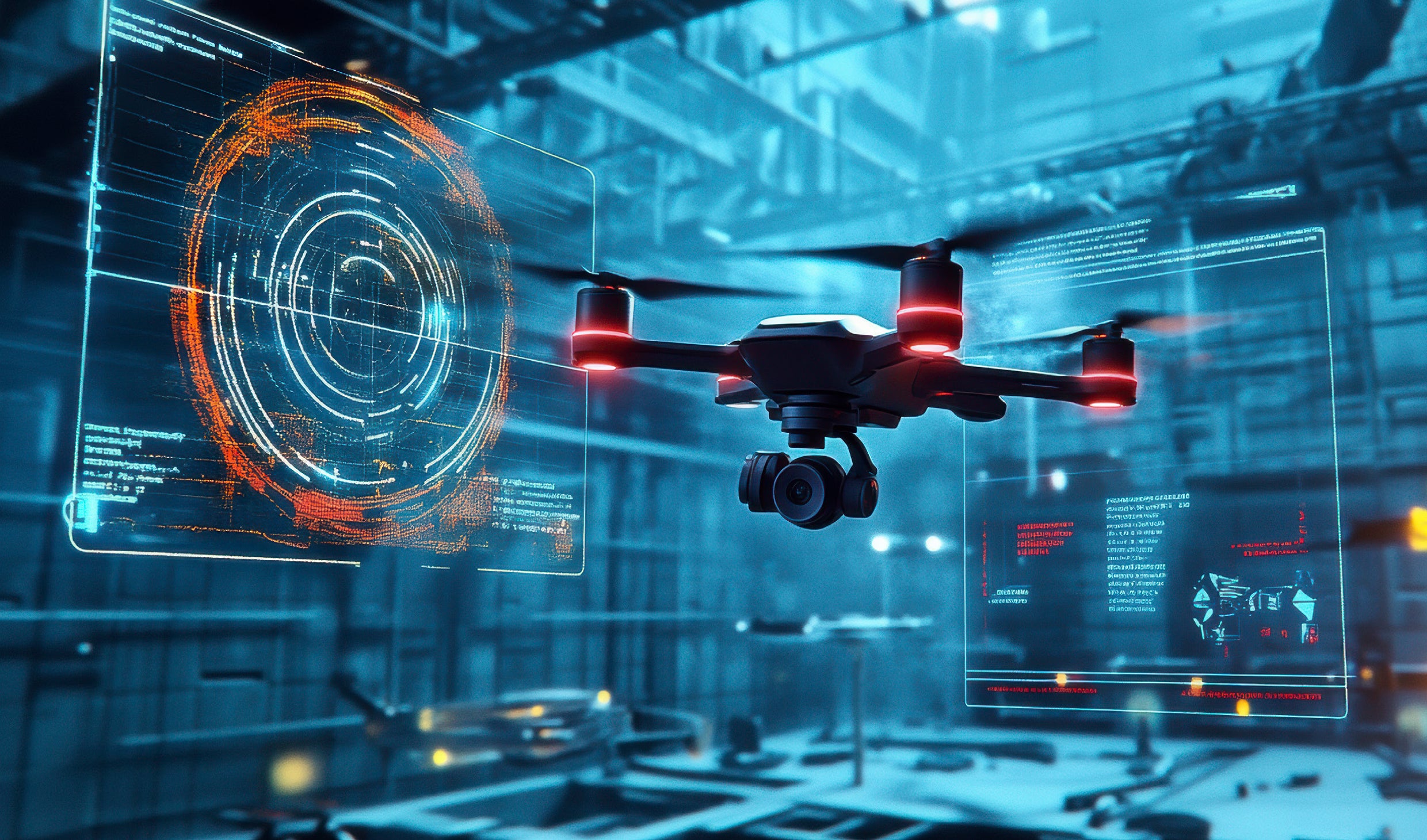Follow CDE
PDF Download

A fast-adaptive estimator for robust flight control draws from the best of both deep-learning techniques and conventional control algorithms to improve drone performance.
Quadcopters, or drones, with their four whirring rotors, have recently become a mainstay technology among militaries, avid hobbyists, and first responders alike. Whether delivering crucial medical supplies to the critically injured or aiding in search and rescue missions in terrains too hazardous for human involvement, advanced, nimble drones have transformed high-stakes operations once limited by battery life and payload constraints.
But as billions of dollars are funnelled into building the next generation of fully autonomous systems, some concerns are still up in the air: Are today’s drones reliable enough for flight over densely populated neighbourhoods? Can their onboard intelligence adapt to the rugged, erratic conditions of the real world?
At the Department of Electrical and Computer Engineering, College of Design and Engineering, National University of Singapore, Assistant Professor Zhao Lin is tackling these questions by developing AI-powered drones. His team has created a fast-adaptive estimator, called a neural moving horizon estimator (NeuroMHE), that leverages the best of deep-learning techniques and conventional control algorithms to enhance disturbance estimation and response. This could mean more robust, reliable flight-control systems for high-performance drones — even in the face of unexpected and severe disruptions.
By leveraging deep-learning techniques alongside conventional control algorithms, a fast-adaptive estimator developed by Assistant Professor Zhao Lin’s team makes drones more robust and reliable.
Fine-tuning the flight game
Today’s drones are far from perfect. Sudden gusts of wind, abrupt shifts in aerodynamics during tight manoeuvres, or sudden changes in payload weight can throw flight stability out of kilter. The consequences can range from minor deviations and delays to severe, costly crashes, especially in high-stakes situations where even a momentary lapse could be catastrophic.
Most current flight-control systems use estimators to manage disturbances, which come with various limitations. They often rely on either highly specialised, manually tuned parameters that need careful adjustment for each specific environment, or extensive datasets for neural networks to ‘learn’ from disturbances along the way. These limit the potential of drones. Tuning parameters manually is time-consuming and requires extensive domain knowledge, while data-intensive neural networks require vast amounts of ground-truth data — actual recorded disturbances — for training, which are difficult to obtain. Both approaches can achieve good accuracy for the specifically tuned flight environment or trained type of disturbances, but are unable to autonomously adapt to drastically new or unforeseen scenarios.
"At its core, NeuroMHE leverages a neural network to finetune parameters automatically, eliminating the need for extensive manual adjustment."
"At its core, NeuroMHE leverages a neural network to finetune parameters automatically, eliminating the need for extensive manual adjustment."
"At its core, NeuroMHE leverages a neural network to finetune parameters automatically, eliminating the need for extensive manual adjustment."
NeuroMHE combines the best of the two worlds — it inherits the generalisability of neural networks and the robustness of the model-based moving horizon estimator (MHE). “At its core, NeuroMHE leverages a neural network to fine-tune parameters automatically, eliminating the need for extensive manual adjustment,” says Asst Prof Zhao. “At the same time, NeuroMHE provides a physical rule-based reliability guarantee, which optimises drone’s performance based on its physical properties in real-time as the drone zips through its environment.”
This unique fusion enables NeuroMHE to anticipate, and counteract, a wide range of severe disturbances on the fly — giving drones a safer, smoother, and more responsive edge.
NeuroMHE combines the best of the two worlds — it inherits the generalisability of neural networks and the robustness of the model-based moving horizon estimator (MHE). “At its core, NeuroMHE leverages a neural network to fine-tune parameters automatically, eliminating the need for extensive manual adjustment,” says Asst Prof Zhao. “At the same time, NeuroMHE provides a physical rule-based reliability guarantee, which optimises drone’s performance based on its physical properties in real-time as the drone zips through its environment.”
This unique fusion enables NeuroMHE to anticipate, and counteract, a wide range of severe disturbances on the fly — giving drones a safer, smoother, and more responsive edge.
Unlike previous methods, the team’s system does not require ground-truth disturbance data for training. “Instead, it learns from tracking errors in the drone’s trajectory — deviations from its intended path — making it more efficient and versatile,” adds Asst Prof Zhao. “The system’s adaptive weighting, a mechanism that adjusts its responsiveness based on current flight conditions, is guided by the neural network, allowing NeuroMHE to tweak its sensitivity to disturbances in real-time.”
To validate NeuroMHE, the team put it through tests in high-speed flight simulations and real-world environments. They challenged the system with a range of flight scenarios, from routine paths to extreme manoeuvres, using both synthetic disturbances and actual environmental data. “Our system outperformed one of the best estimators today, NeuroBEM, reducing force estimation errors by up to 76.7% using a fraction of the computational load. In addition, NeuroMHE’s compact neural network requires only 7.7% of the parameters used in NeuroBEM, making it a lightweight yet powerful solution for robust flight control,” adds Asst Prof Zhao.
Taking flight
NeuroMHE’s ability to adapt to unexpected disturbances gives it potential for applications where reliability is paramount — from disaster response to autonomous delivery in dense urban areas, and even precision agriculture where labour shortages are increasingly gripping the sector.
"Its adaptable framework can also be generalised to complement other robotic systems that require robust control in dynamic environments, such as underwater or space exploration vehicles."
"Its adaptable framework can also be generalised to complement other robotic systems that require robust control in dynamic environments, such as underwater or space exploration vehicles."
“Its adaptable framework can also be generalised to complement other robotic systems that require robust control in dynamic environments, such as underwater or space exploration vehicles,” says Asst Prof Zhao.
To make drone systems even more versatile, the team’s future developments will focus on refining training algorithms for faster, more efficient learning, and integrating NeuroMHE with controllers to create a unified system that optimises both estimation and control simultaneously. A better path for autonomous flight is already in sight.
"Its adaptable framework can also be generalised to complement other robotic systems that require robust control in dynamic environments, such as underwater or space exploration vehicles."
“Its adaptable framework can also be generalised to complement other robotic systems that require robust control in dynamic environments, such as underwater or space exploration vehicles,” says Asst Prof Zhao.
To make drone systems even more versatile, the team’s future developments will focus on refining training algorithms for faster, more efficient learning, and integrating NeuroMHE with controllers to create a unified system that optimises both estimation and control simultaneously. A better path for autonomous flight is already in sight.
Read More
View Our Publications ▏Back to Forging New Frontiers - January 2025 Issue
If you are interested to connect with us, email us at cdenews@nus.edu.sg









